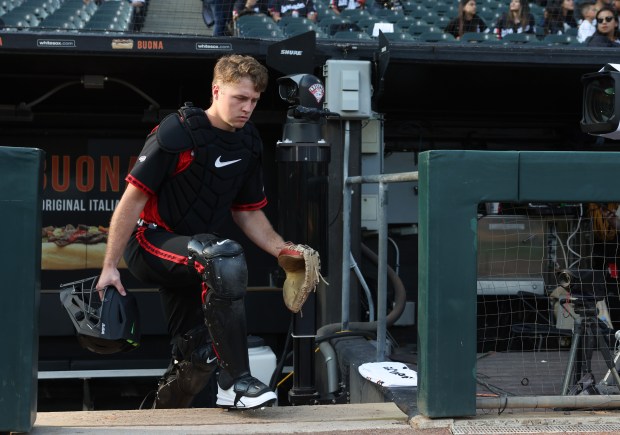CINCINNATI — The Chicago Cubs employed a narrow focus in the lead-up to Tuesday’s trade deadline.
Unlike their massive sell-off in 2021 when their top acquisitions were in the lower levels, far away from the majors, president of baseball operations Jed Hoyer made clear over the last 10 days that the Cubs wanted deals that would bring in talent to help as soon as 2025.
“The goal wasn’t just to accumulate assets,” Hoyer said Tuesday night following a largely quiet deadline day for the organization. “This year was very focused on sort of next year and beyond. And so I think from that standpoint we were really consistent with what we did.”
The Cubs ultimately traded only three players from their 40-man roster — third baseman Christopher Morel, reliever Mark Leiter Jr. and right-hander Hunter Bigge, who was part of Triple-A Iowa’s bullpen — along with three minor leaguers (right-hander Ty Johnson, outfielder Yohendrick Pinango and shortstop Josh Rivera). Those six players landed the Cubs third baseman Isaac Paredes, right-hander Nate Pearson and two minor-leaguers, right-hander Jack Neely and infielder Ben Cowles.
“There were some deals or even concepts I thought would probably get done that didn’t for whatever reason,” Hoyer said. “And the longer I do this, I’m always reminded over and over and over it’s hard to get a trade from concept to conclusion. … But, yeah, we had some deals that conceptually I thought were probably going to be close that for whatever reason it kind of went away at the end.”
Hoyer didn’t want to discuss players the Cubs did not trade. It’s a group that most notably includes reliever Héctor Neris and right-hander Jameson Taillon, who has two years, $36 million remaining on his contract and holds a limited 10-team no-trade clause.
“A lot of players were asked about, a lot of deals bounced around, some casually, some more seriously,” Hoyer said. “But commenting on guys we didn’t trade or why doesn’t make a lot of sense because it leads to speculation.”
Whether this becomes a successful trade deadline for the Cubs largely hinges on the swap of third basemen, Morel and Paredes. Moving on from Morel and the high ceiling he still possesses could be painful down the line if he’s able to harness his immense power more reliably and stick at a position defensively with the Tampa Bay Rays. He quickly showed why the Rays wanted him, homering in his second at-bat Tuesday night. Paredes went 0-for-4 in his debut during the Cubs’ 6-3 loss to the Reds.
Double-A infielder Ben Cowles, who the Cubs acquired from Yankees in the Leiter trade, will probably miss the rest of the regular season after getting hit on his wrist a couple days ago, Jed Hoyer said.
— Meghan Montemurro (@M_Montemurro) July 30, 2024
Hoyer had been talking with Rays president of baseball operations Erik Neander over the last three to four weeks circling around this type of deal. The Cubs knew a lot of other teams were interested in Paredes, but the two sides were able to find a trade that worked for both teams. Hoyer called it a hard trade to make because of how long Morel has been in the organization, signing in 2015 at 16 years old out of the Dominican Republic, and as a person he is “as wonderful human as I’ve been around … everyone loves him.”
But the Cubs wanted more consistency at third base and know Paredes is capable of providing that.
“I really do believe in Chris’ expected numbers at the plate,” Hoyer said. “I think he made real progress, which we were proud of. I think he’s going to go on and have a ton of success. I wish him the best. I think he’s a really good hitter. Ultimately, positionally, we felt like it was the right decision for 2025 and beyond.”
Hoyer didn’t make the trade for Paredes to switch things up for a stagnant lineup, noting “I would never do a deal like that just to shake it up.” But the Cubs now have two months to evaluate an offensive group that hasn’t been good enough this season outside of a strong April. Hoyer wants to see progress over the final 53 games. The Cubs (51-58) simply haven’t been good enough, especially offensively.
Now that they are through the deadline, the hope is any anxiety players might experience with trade uncertainty can dissipate. What should be an exciting eight-week push to get into the playoffs, the Cubs instead are in a disappointing position when reaching the postseason was the expectation coming into the year.
“Two months is a lot of baseball, it’s highly unlikely to be enough to get back in the race,” Hoyer said. “But that doesn’t mean these games aren’t really important as we try to evaluate what the offense is going into next year. I’m hoping that we stabilize and start to show that we could be a solid offense like we were last year because this has been really frustrating.”
Hoyer knows there will rightfully be a lot of questions about the Cubs’ offensive production heading into the offseason if the group doesn’t collectively turn it around. Put bluntly by Hoyer: “How do we fix an offense that with the same players went from a very good offense in ’23 to a well-below-average offense in ’24?”




